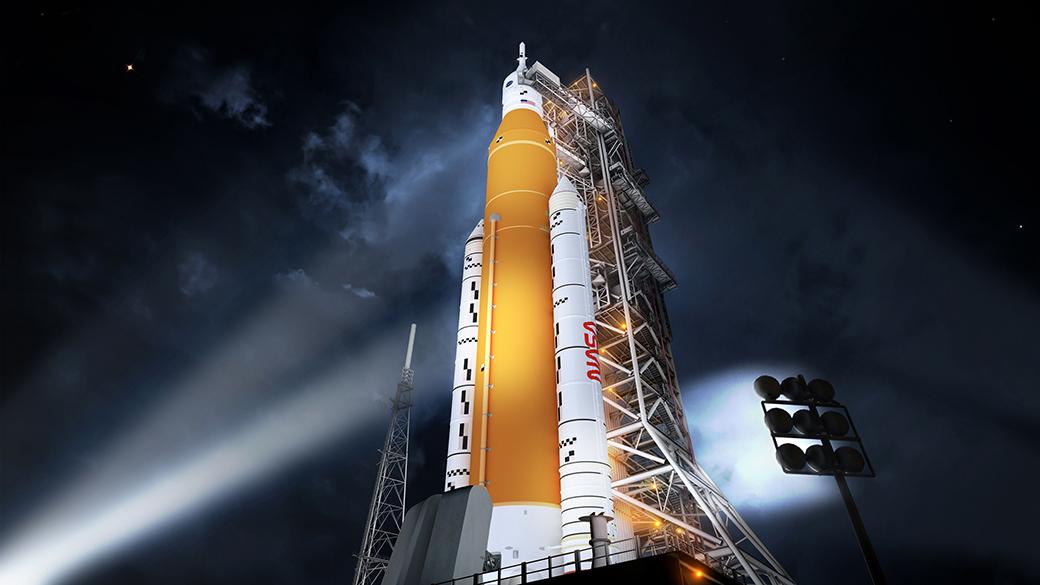
CAPE CANAVERAL—Following ongoing work to repair a hydrogen leak that derailed the inaugural launch of the Space Launch System (SLS) rocket on Sept. 3, NASA plans to conduct a tanking test at Kennedy Space Center Launch Complex 39B as early as Sept. 17.
If the repair proves successful, NASA is aiming to be ready to launch at 6:47 a.m. EDT on Sept. 23, pending approval by the U.S. Space Force Eastern Range safety office. It supports launches from the Kennedy Space Center (KSC) and Cape Canaveral Space Force Station.
NASA on Sept. 8 formally requested a waiver to fly the SLS prior to re-testing batteries on the rocket’s flight-termination system, which would be detonated if the 32-story rocket veered off course during ascent, threatening populated areas. The system’s current 25-day certification expired on Sept. 6. Re-testing cannot be done at the launchpad, so if the Space Force declines, the SLS and Orion spacecraft would be returned to the Vehicle Assembly Building, pushing the next launch attempt back to mid- to late October.
“The test data shows considerable time beyond the requested waiver for the re-test requirements,” SLS chief engineer John Blevins told reporters on Sept. 8, declining to cite specific numbers.
“The range is responsible for public safety,” he noted. “Ultimately they have to look at [the test data] from a statistical standpoint and make sure they believe that safety is supported.”
Meanwhile, technicians at Launch Complex 39B assembled an enclosure around access stands on the SLS mobile launcher’s tail service mast umbilical (TSMU) to protect hardware from weather and contamination. They then proceeded to remove and replace seals on an 8-in. quick-disconnect fitting used to fill and drain the SLS’s core and upper stage liquid-hydrogen (LH2) tanks.
The quick-disconnect showed unacceptably high levels of hydrogen during NASA’s last attempt on Sept. 3 to launch the SLS and Orion spacecraft on the Artemis I flight test. That is the kickoff mission for NASA’s first deep-space human-exploration program since the Apollo Moon program 50 years ago.
As a precaution, technicians also replaced seals on a 4-in. quick-disconnect hydrogen bleed line. “They are both at the flight-to-ground interface between the LH2 TSMU and the core stage,” Blevins said.
Initial inspection of the seals showed what Blevins described as “a very minor notch” on the 8-in. seal, which will be more closely examined, and not much on the 4-in. seal. “We’ll be looking at that more deeply as we get the seals out,” he said.
“We’re making great progress,” Blevins added.
After verifying the installation work, NASA plans to test the seals at cryogenic temperatures during a full tanking test, targeted for Sept. 17.
The preliminary plan is to fill both the SLS core and upper stages with more than 750,000 gal. of LH2 and liquid oxygen to demonstrate not only that the seals are working, but also to test some changes in tanking procedures and software, Blevins said.
The KSC launch team, which already has conducted four wet-dress rehearsals and two launch attempts, wants to modify its concept of operations to reduce the number of pressure and flow changes during tanking in an effort to mitigate the chance of leaks.
“We’re calling it ‘a kinder and gentler approach’ to tanking,” Blevins said. “We think that might reduce the stress of pulses or sudden changes on the seals.”
“We’re optimistic that we can knock this problem flat and have a successful tanking,” he added. “As always, we’ll launch when we’re ready.”
In addition to the Sept. 23 launch opportunity, NASA has reserved Sept. 27 with the Eastern Range as a backup launch date.

